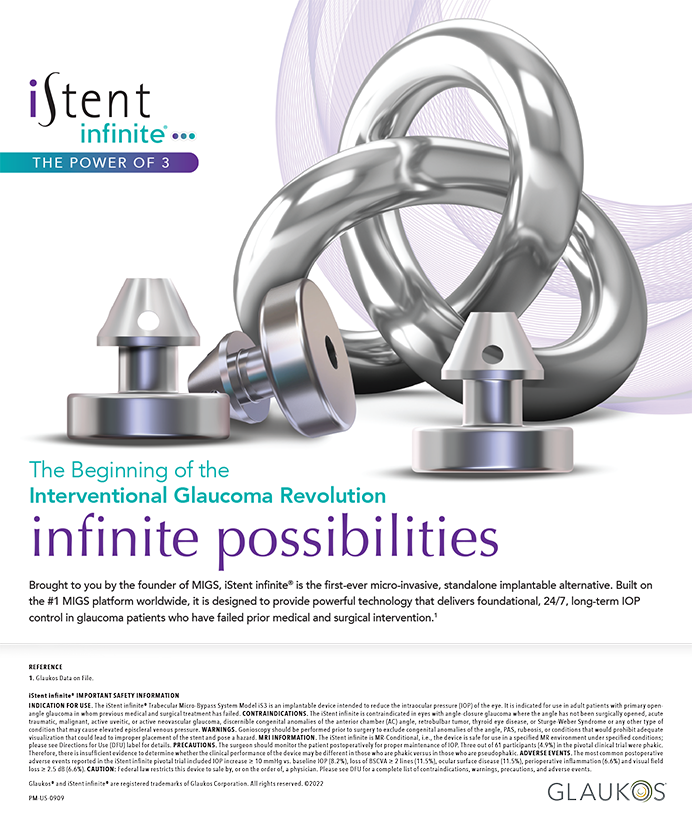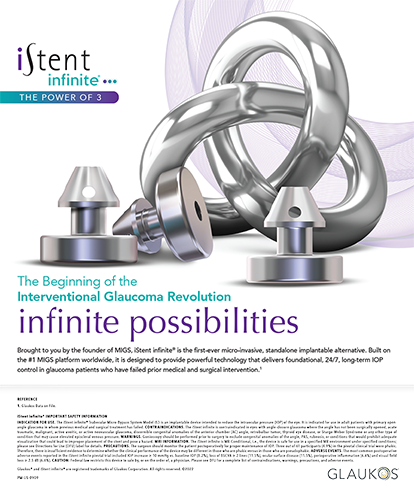Performing LASIK on an eye with undiagnosed keratoconus invites serious consequences. Detecting keratoconus preoperatively is a major safety issue we as ophthalmic surgeons face. I developed a particular interest in detecting the condition early, as it is the one ocular variable that can potentially stump even the most careful surgeon when assessing patients for corneal refractive surgery. The corneal epithelium has an uncanny ability to re-establish a smooth surface. This biological phenomenon provides an essential mechanism for preserving vision in corneal injury and disease. Unfortunately, epithelial compensation means that the stromal surface's irregularities are masked from diagnosis on topography. We can, however, put this to use by examining the epithelial-thickness profile. Any departure from a normal epithelial-thickness profile can be used as an extremely sensitive indicator of the stromal surface's irregularity.
THE ARTEMIS
Artemis very high-frequency (VHF) digital ultrasound arc scanning technology (Ultralink LLC, St. Petersburg, FL) provides extremely high-resolution ultrasound B-scans of the cornea that show a clear delineation of the epithelial and Bowman's surfaces as well as the back surface of the cornea. Using these data, the Artemis technology provides three-dimensional mapping of individual corneal layers over a 10-mm diameter with 1-µm precision.1 With the ability to measure epithelial and stromal-thickness profiles, my colleagues and I set out to investigate how these varied according to the pathology of the cornea.
EPITHELIAL THICKNESS
In a study of 110 normal eyes, we found that the epithelium was not a layer of homogeneous thickness as we had previously thought; rather, it followed a very distinct pattern. On average, the epithelium was approximately 6.0 µm thicker inferiorly than superiorly and about 1.5 µm thicker nasally than temporally, with the thinnest epithelial point displaced superotemporally. The epithelial thickness was consistent across the population, with an average central epithelial thickness of 53.0 µm and a standard deviation of only 4.6 µm.
In a study of 38 keratoconic eyes, we found that there was an inferotemporal region of thin epithelium surrounded by epithelial thickening. This pattern coincided with the cone on topography, thus demonstrating how the epithelium thins and thickens as it tries to compensate for stromal steepening. This pattern was distinct from the one we found in normal corneas. Furthermore, both the thin and thick epithelia we found in keratoconic eyes were significantly outside the range of epithelial thickness found in normal corneas.
Using average epithelial-thickness profiles and limits of epithelial thickness for normal and keratoconic corneas, it occurred to me that perhaps Artemis profiles could be used to confirm or exclude a diagnosis of keratoconus in eyes suggestive of, but not conclusive for, the disease on topography. Epithelial thinning over an area of topographic steepening surrounded by thicker epithelium would indicate keratoconus. On the other hand, thicker epithelium over an area of topographic steepening would imply that the steepening was not due to a keratoconic cone but more likely due to epithelial asymmetry.
In early keratoconic deformity, many have shown that a cone may first appear on the cornea's back surface, rendering back-surface topography a useful tool in alerting us to the possible presence of keratoconus. Not all back-surface asymmetry unaccompanied by front-surface asymmetry will be due to keratoconus, however. The coincidence of epithelial thinning together with a back-surface apical eccentricity will indicate whether or not to ascribe significance to back-surface changes concurrent with normal front-surface topography. The Artemis can detect localized compensatory changes in epithelial profiles once they exceed 2 µm. Therefore, this technique provides increased sensitivity and specificity to any diagnosis of keratoconus well in advance of any detectable corneal, outer-surface, topographic change.
Mapping of the epithelial-thickness profile has proven to be extremely useful in my colleagues and my practice in two important ways. We can exclude the right patients by detecting keratoconus earlier or confirming keratoconus in cases where we may have considered topographic changes to be "within normal limits," and we can include many patients who otherwise would have been denied treatment.
CONFIRMING KERATOCONUS
Artemis Versus Front- and Back-Surface Topography
My colleagues and I studied what percentage of eyes would be confirmed as keratoconic by epithelial-thickness profiles that were clinically suggestive of keratoconus by front- and back-surface topography. We examined 133 eyes identified as suspicious for keratoconus. Eyes showing a displaced back-surface apex measured with the Orbscan topographer (Bausch & Lomb, Rochester, NY), inferior steepening on Atlas front-surface topography (Carl Zeiss Meditec, Inc., Dublin, CA), and against-the-rule astigmatism or significant coma measured with the WASCA aberrometer (Carl Zeiss Meditec, Inc.) were classified as suspicious for keratoconus. We performed an Artemis measurement and used epithelial-thickness profiles to classify the diagnosis of keratoconus. We considered the coincidence of a region of thin surrounded by thicker epithelium coincident with the suspected cone as a diagnosis of keratoconus. The following examples are from this study.
Case Study No. 1
An 18-year-old female with -3.25 D sphere in both eyes and -0.25 D of cylinder in one eye wanted to undergo LASIK before attending college. Her keratometry, front-surface corneal topography, and corneal thickness measures were standard in both eyes, and the patient seemed to be a good candidate for surgery. Her epithelial-thickness profile on the Artemis scan, however, showed a thinning of the epithelium corresponding to a displaced posterior surface apex, thereby masking the bulging of the anterior stromal surface.
We believed that we were actually detecting keratoconus before it was evident on the front surface, thanks to the analysis of the epithelial-thickness profile provided by the Artemis. The patient might have developed ectasia had we proceeded with the surgery.
Case Study No. 2
An Australian professional cricket player requested refractive surgery. The patient's refraction (oblique, against-the-rule astigmatism) had been stable for about 20 years, and he had normal keratometric and corneal thickness measurements. Wavefront analysis also showed normal root mean square spot size values and very low coma. Although the patient seemed a good candidate for surgery, an Artemis scan showed an epithelial-thickness profile with a thinning of the epithelium corresponding to an inferiorly displaced posterior-surface apex in both eyes.
In this case, we did not proceed with refractive surgery, despite the fact that there was very low coma and normal topography, because we believed that the hidden cone was compensated for by the epithelia thinning.
Case Study No. 3
A 33-year-old female with -4.75 D sphere and -0.75 D cylinder in one eye and -4.00 D sphere and -0.50 D cylinder in the other wanted to undergo LASIK. She had normal keratometric values and normal pachymetry. WASCA aberrometry, however, showed a very high degree of coma (9 µm of Seidel coma), and one eye had a displaced back surface on Orbscan topography with inferior steepening on the anterior surface. Furthermore, her brother had keratoconus.
Comparing the patient's epithelial-thickness profile with the wavefront pattern, we found that the asymmetric elevation in the higher-order optics—which would have designated the cone of keratoconus—did not correspond with epithelial thinning that was surrounded by thickening. Instead, the epithelial-thickness profile showed a concentric-to-the-center pattern. We knew, therefore, that there was no cone on the anterior surface of the cornea and that we were not dealing with a case of keratoconus.
The patient proceeded with surgery. One year after wavefront-guided LASIK with the MEL80 (Carl Zeiss Meditec, Inc.), the patient's coma was reduced to 1 µm (Seidel coma), and she had gained one line of BCVA. Her refraction has been stable since the 1-month visit. This outcome supported the exclusion of keratoconus that was made by the Artemis despite the topographic and wavefront warning signs that presented preoperatively.
CONCLUSION
Of the population of eyes suggestive of keratoconus, the diagnosis of keratoconus was excluded by Artemis epithelial-thickness profiles in 83, and keratoconus was confirmed in 17.
Epithelial-thickness profiles have the potential for helping ophthalmologists avoid surgery on corneas that would otherwise have been deemed suitable. These profiles also identify patients who might otherwise be rejected because of equivocal topographic findings and allow such patients to benefit from surgery.
Dan Z. Reinstein, MD, MA(Cantab), FRCSC, DABO, FRCOphth, is Medical Director of the London Vision Clinic in London. He holds a financial interest in the Artemis technology through patents administered by the Cornell Research Foundation and Ultralink LLC. Dr. Reinstein may be reached at 44 20 7224 1005; dzr@londonvisionclinic.com.


